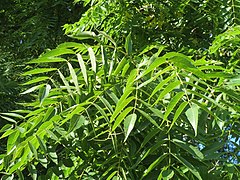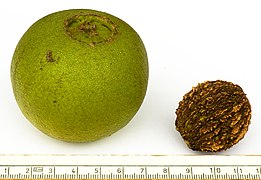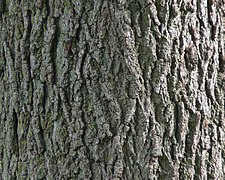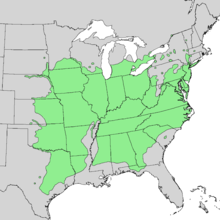Black walnut
| Black walnut | ||||||||||||
|---|---|---|---|---|---|---|---|---|---|---|---|---|

Black walnut ( Juglans nigra ) |
||||||||||||
| Systematics | ||||||||||||
|
||||||||||||
| Scientific name | ||||||||||||
| Juglans nigra | ||||||||||||
| L. |
The black walnut tree ( Juglans nigra ) is a species of the walnut family (Juglandaceae). The black walnut grows in eastern North America and Texas, where it serves as a supplier of timber . Their fruits are edible. In Europe it is used as an ornamental tree or as a base for finishing of walnut trees used.
description
The black walnut tree is a deciduous tree 20 to 30 meters tall or higher . The growth rate can be up to 1.13 meters per year. The trunk diameter can reach a good 1–2.5 meters. The thick bark is gray-brown and furrowed.
It has unpaired or paired pinnate, stalked leaves with 12–22 or more, ovate to lanceolate, serrated on the edge, finely pubescent on the underside and short-stalked, pointed leaflets . On the upper side, except on the central vein, they are bald, and underneath they are glandular and scaly. The leaves are about 30–60 centimeters long, the leaflets about 6–15 centimeters. The nerve is pinnate and more or less impressed on the upper side. The autumn color is yellow.
Juglans nigra is monoecious and heterodichogamous . The male flowers are in pendulous catkins up to 10 centimeters long , the female in terminal groups ( ears ) up to five. The yellow-greenish, unisexual flowers have a simple inflorescence, the petals are missing. In the female, seated blossoms under constant is ovary with the big feathery scars with the finely glandular-haired, mehrzipfligen deck and Perianthblättern (4 sepals) grown. In the male, almost sessile flowers, the bracts and the perianth have grown together to form a multi-lobed, flat cup which contains up to 40 very small stamens .
The green to yellow-brownish fruit ( false fruit ) is round, fine-black, finely glandular and partly finely scaly, and about 4–8 centimeters in size and with scars at the tip. The mostly coarsely furrowed to ribbed, brown to dark brown and roundish to ellipsoidal, very hard, thick-shelled and solitary nuts (seeds) with four partitions are 2.5–4 centimeters in size.
The number of chromosomes is 2n = 32.
distribution
The black walnut has its natural range in the eastern half of the USA. Around 1900 black walnut trees were settled in the Rhine and Donauau forests , today they form significant populations there. Black walnut trees are often attacked by the white berry mistletoe in Central Europe .
ingredients
The black walnut contains polyphenols , tannins , naphthoquinone as juglone and hydrojuglon glycoside, essential oil , fatty acids and alkanes . Juglone causes the dying plant organs to turn black, it has a phytotoxic effect on surrounding plants and is also poisonous for fish and fungi .
use

The black walnut is an impressive park tree when it stands free. Then it develops a mighty, round crown. Recently, the black walnut has also been cultivated in forestry .
The hard shell of the fruit can be opened by using special crackers. The cotyledons obtained in this way are used in the USA in confectionery and in ice cream production. They are rich in fatty oils and are also used as walnut oil .
The beautiful wood is very decorative, heavy, hard, fine-grained and very durable. It is easy to work with, sticks well, does not deform, shrink or swell and is easy to polish. It is used in furniture construction and interior design as well as in shipbuilding and as a veneer. It is also used for carving and turning .
literature
- Michael Hickey, Clive King: 100 Families of Flowering Plants. Second Edition, Cambridge Univ. Press, 1988, ISBN 978-0-521-33049-7 , pp. 53 f.
- Marilena Idžojtić: Dendrology. Academic Press, 2018, ISBN 978-0-444-64175-5 , p. 348.
- Theo. Holm: Morphological Study of Carya alba and Juglans nigra. In: Botanical Gazette. 72 (6), pp. 375-389, 1921, archive.org .
- Norbert Bartsch : On the cultivation of the black walnut (Juglans nigra L.) in the Rhine meadows. Writings from the Forest Faculty of the University of Göttingen and the Northwest German Forest Research Institute (Volume 95). Sauerländer, Frankfurt am Main 1989, 90 pages, ISBN 3-7939-5095-6 .
- Dietmar Aichele, Heinz-Werner Schwegler: Which tree is that? Kosmos Naturführer, 24th edition, Franckh-Kosmos, 1992, ISBN 3-440-06570-7 .
- Schmeil-Fitschen: Interactive flora of Germany. Quelle & Meyer, 2004, ISBN 3-494-01368-3 .
- Wolfgang Franke: crop science. Georg Thieme-Verlag, Stuttgart 1997, ISBN 978-3-13-530406-9 .
- Juglans nigra in the Flora of Noth America, Vol. 3.
- P. Pollegioni, K. Woeste, I. Olimpieri et al .: Pollen biology and hybridization process: Open problem in walnut. In: Benjamin J. Kaiser: Pollen: Structure, Types and Effects. Nova Science Pub., 2010, pp. 65-99, ISBN 978-1-61668-669-7 , online at researchgate.net.
Web links
- Thomas Meyer: Data sheet with identification key and photos at Flora-de: Flora von Deutschland (old name of the website: Flowers in Swabia ).
- under Juglans nigra at Oregon State University (with many pictures).
- Juglans nigra at Useful Temperate Plants.
- Information on baumkunde.de.
- Information about the tree from US Forest Service
- Old black walnut tree in Bamberg / St. Martin on apfelweibla.de.
- Andreas Ehring, Oswald Keller (2010): The black walnut tree (Juglans nigra): Valuable, but with high standards at waldwissen.net .
- Description and pictures at missouriplants.com.
- Wood description on materialarchiv.ch.
Individual evidence
- ↑ P. Pollegioni, K. Woeste, A. Major et al .: Characterization of Juglans nigra (L.), Juglans regia (L.) and Juglans x intermedia (Carr.) By SSR markers: a case study in Italy. In: Silvae Genetica. 58, 1-2, 2009, pp. 68-78, doi: 10.1515 / sg-2009-0009 .
- ^ Erich Oberdorfer : Plant-sociological excursion flora for Germany and neighboring areas. 8th edition, Verlag Eugen Ulmer, Stuttgart 2001, ISBN 3-8001-3131-5 , p. 311.






